Bibliometric Trends and Insights into the Potential of Maize (Zea mays) under the Framework of Conservation Agriculture
Abstract
:1. Introduction
- What is the connection between the growth in publications and citations of maize under various aspects of CA scenarios?
- What are the overall numbers of articles published in each research area, and what is the subject matter where these articles are most frequently found?
- What significant fluctuations has the literature undergone over time?
- How many articles are linked to a particular SDG under the present theme?
- What is the intellectual framework that highlights the prominent authors and top organizations conducting and publishing agricultural research focusing on the agri-food systems involving maize regarding CA aspects?
- What are the top collaboration networks among authors, organizations, and countries that are engaged in maize research under CA systems?
- What are the implications along with future lines of work of maize research under CA systems subjected to the scenario of decreasing agricultural land coupled with the rapid changing of the global climate?
2. Methodology
2.1. René Descartes’s Discourse Framework in Bibliometric Analysis
2.1.1. Step 1: Doubt Stage
2.1.2. Step 2: Partition of Problem
2.1.3. Step 3: Problem Solving Approach
2.1.4. Step 4: Inspection and Review
2.2. Retrieval of Pertaining Literature
2.3. Screening of Retrieved Literature
2.4. Scientific Analysis of Dataset
3. Results
3.1. Performance Analysis of Publications
3.1.1. Growth Patterns of Total Publications (TPs) over the Years
3.1.2. Scientific Contributions by Countries
3.1.3. Count of Total Publications in Various Research Categories and Different Themes of SDGs
3.1.4. The Most Impactful Journals
3.1.5. The Most Influential Authors
3.2. Science Mapping of Documents
3.2.1. Visualization of Authors
Citation Analysis of Authors
Co-Authorship Analysis of Authors
3.2.2. Visualization of Journals
Citation Analysis of Journals
Co-Citation Analysis of Journals
3.2.3. Visualization of Words
3.2.4. Visualization of Organizations
3.2.5. Visualization of Countries
4. Discussion
5. Implications and Future Prospects
6. Conclusions
Author Contributions
Funding
Institutional Review Board Statement
Informed Consent Statement
Data Availability Statement
Acknowledgments
Conflicts of Interest
References
- Giller, K.E.; Delaune, T.; Silva, J.V.; Descheemaeker, K.; van de Ven, G.; Schut, A.G.T.; van Wijk, M.; Hammond, J.; Hochman, Z.; Taulya, G.; et al. The future of farming: Who will produce our food? Food Secur. 2021, 13, 1073–1099. [Google Scholar] [CrossRef]
- Jat, M.L.; Chakraborty, D.; Ladha, J.K.; Rana, D.S.; Gathala, M.K.; McDonald, A.; Gerard, B. Conservation agriculture for sustainable intensification in South Asia. Nat. Sustain. 2020, 3, 336–343. [Google Scholar] [CrossRef]
- Islam, M.A.; Pariyar, S.; Krupnik, T.J.; Becker, M. Changing Trends in Crop Management Practices and Performance Attributes of Rice-Based Systems of Coastal Bangladesh. Front. Agron. 2024, 6, 1397474. [Google Scholar] [CrossRef]
- Singh, S.; Kiran, B.R.; Mohan, S.V. Carbon Farming: A Circular Framework to Augment CO2 Sinks and to Combat Climate Change. Env. Sci. Adv. 2024, 3, 522–542. [Google Scholar] [CrossRef]
- Liu, Z.; Cao, S.; Sun, Z.; Wang, H.; Qu, S.; Lei, N.; He, J.; Dong, Q. Tillage effects on soil properties and crop yield after land reclamation. Sci. Rep. 2021, 11, 4611. [Google Scholar] [CrossRef] [PubMed]
- Powlson, D.S.; Stirling, C.M.; Thierfelder, C.; White, R.P.; Jat, M.L. Does conservation agriculture deliver climate change mitigation through soil carbon sequestration in tropical agro-ecosystems? Agric. Ecosyst. Environ. 2016, 220, 164–174. [Google Scholar] [CrossRef]
- Kumar, R.; Choudhary, J.S.; Naik, S.K.; Mondal, S.; Mishra, J.S.; Poonia, S.P.; Kumar, S.; Hans, H.; Kumar, S.; Das, A.; et al. Influence of Conservation Agriculture-Based Production Systems on Bacterial Diversity and Soil Quality in Rice-Wheat-Greengram Cropping System in Eastern Indo-Gangetic Plains of India. Front. Microbiol. 2023, 14, 1181317. [Google Scholar] [CrossRef]
- Kassam, A.; Friedrich, T.; Derpsch, R. Successful experiences and lessons from conservation agriculture worldwide. Agronomy 2022, 12, 769. [Google Scholar] [CrossRef]
- Francaviglia, R.; Almagro, M.; Vicente-Vicente, J.L. Conservation agriculture and soil organic carbon: Principles, processes, practices and policy options. Soil. Syst. 2023, 7, 17. [Google Scholar] [CrossRef]
- Thierfelder, C.; Wall, P.C. Rotation in conservation agriculture systems of Zambia: Effects on soil quality and water relations. Exp. Agric. 2010, 46, 309–325. [Google Scholar] [CrossRef]
- TDas, K.; Bhattacharyya, R.; Sudhishri, S.; Sharma, A.R.; Saharawat, Y.S.; Bandyopadhyay, K.K.; Sepat, S.; Bana, R.S.; Aggarwal, P.; Sharma, R.K.; et al. Conservation agriculture in an irrigated cotton–wheat system of the western Indo-Gangetic Plains: Crop and water productivity and economic profitability. Field Crops Res. 2014, 158, 24–33. [Google Scholar] [CrossRef]
- Jahangir, M.M.R.; Nitu, T.T.; Uddin, S.; Siddaka, A.; Sarker, P.; Khan, S.; Jahiruddin, M.; Müller, C. Carbon and Nitrogen Accumulation in Soils under Conservation Agriculture Practices Decreases with Nitrogen Application Rates. Appl. Soil. Ecol. 2021, 168, 104178. [Google Scholar] [CrossRef]
- Brouder, S.M.; Gomez-Macpherson, H. The impact of conservation agriculture on smallholder agricultural yields: A scoping review of the evidence. Agric. Ecosyst. Environ. 2014, 187, 11–32. [Google Scholar] [CrossRef]
- Choudhary, K.M.; Jat, H.S.; Nandal, D.P.; Bishnoi, D.K.; Sutaliya, J.M.; Choudhary, M.; Yadvinder-Singh; Sharma, P.C.; Jat, M.L. Evaluating Alternatives to Rice-Wheat System in Western Indo-Gangetic Plains: Crop Yields. Water Productivity and Economic Profitability. Field Crops Res. 2018, 218, 1–10. [Google Scholar] [CrossRef]
- Padhan, S.R.; Jat, S.L.; Singh, A.K.; Parihar, C.M.; Pooniya, V.; Kumar, S.; Meena, M.C.; Radheshyam; Kumar, A.; Darjee, S. Nitrogen dose and placement in conservation agriculture for augmenting cropgrowth, productivity and profitability of Indian mustard (Brassica juncea). Indian J. Agric. Sci. 2023, 93, 1326–1332. [Google Scholar] [CrossRef]
- Ahmad, I.; Ahmad, B.; Boote, K.; Hoogenboom, G. Adaptation strategies for maize production under climate change for semi-arid environments. Eur. J. Agron. 2020, 115, 126040. [Google Scholar] [CrossRef]
- Zhang, Z.; Wei, J.; Li, J.; Jia, Y.; Wang, W.; Li, J.; Lei, Z.; Gao, M. The impact of climate change on maize production: Empirical findings and implications for sustainable agricultural development. Front. Environ. Sci. 2022, 10, 954940. [Google Scholar] [CrossRef]
- Tokatlidis, I.S. Adapting maize crop to climate change. Agron. Sustain. Dev. 2013, 33, 63–79. [Google Scholar] [CrossRef]
- Tuti, M.D.; Rapolu, M.K.; Sreedevi, B.; Bandumula, N.; Kuchi, S.; Bandeppa, S.; Saha, S.; Parmar, B.; Rathod, S.; Ondrasek, G.; et al. Sustainable Intensification of a Rice–Maize System through Conservation Agriculture to Enhance System Productivity in Southern India. Plants 2022, 11, 1229. [Google Scholar] [CrossRef]
- Grote, U.; Fasse, A.; Nguyen, T.T.; Erenstein, O. Food security and the dynamics of wheat and maize value chains in Africa and Asia. Front. Sustain. Food Syst. 2021, 4, 617009. [Google Scholar] [CrossRef]
- Padhan, S.R.; Jat, S.L.; Mishra, P.; Darjee, S.; Saini, S.; Padhan, S.R.; Radheshyam; Ranjan, S. Corn for Biofuel: Status, Prospects and Implications. In New Prospects of Maize; Kaushik, P., Ed.; IntechOpen: London, UK, 2024. [Google Scholar] [CrossRef]
- CThierfelder; Matemba-Mutasa, R.; Rusinamhodzi, L. Yield response of maize (Zea mays L.) to conservation agriculture cropping system in Southern Africa. Soil. Tillage Res. 2015, 146, 230–242. [Google Scholar] [CrossRef]
- Pooniya, V.; Zhiipao, R.R.; Biswakarma, N.; Kumar, D.; Shivay, Y.S.; Babu, S.; Das, K.; Choudhary, A.K.; Swarnalakshmi, K.; Jat, R.D.; et al. Conservation agriculture based integrated crop management sustains productivity and economic profitability along with soil properties of the maize-wheat rotation. Sci. Rep. 2022, 12, 1962. [Google Scholar] [CrossRef] [PubMed]
- Galani, Y.J.H.; Ligowe, I.S.; Kieffer, M.; Kamalongo, D.; Kambwiri, A.M.; Kuwali, P.; Thierfelder, C.; Dougill, A.J.; Gong, Y.Y.; Orfila, C. Conservation agriculture affects grain and nutrient yields of maize (Zea mays L.) and can impact food and nutrition security in Sub-Saharan Africa. Front. Nutr. 2022, 8, 804663. [Google Scholar] [CrossRef] [PubMed]
- Aramburu-Merlos, F.; Tenorio, F.A.M.; Mashingaidze, N.; Sananka, A.; Aston, S.; Ojeda, J.J.; Grassini, P. Adopting yield-improving practices to meet maize demand in Sub-Saharan Africa without cropland expansion. Nat. Commun. 2024, 15, 4492. [Google Scholar] [CrossRef]
- Sheoran, S.; Kaur, Y.; Kumar, S.; Shukla, S.; Rakshit, S.; Kumar, R. Recent advances for drought stress tolerance in maize (Zea mays L.): Present status and future prospects. Front. Plant Sci. 2022, 13, 872566. [Google Scholar] [CrossRef] [PubMed]
- Shyam, C.S.; Rathore, S.S.; Shekhawat, K.; Singh, R.K.; Padhan, S.R.; Singh, V.K. Precision nutrient management in maize (Zea mays) for higher productivity and profitability. Indian J. Agric. Sci. 2021, 91, 933–935. [Google Scholar] [CrossRef]
- Huang, S.; He, P.; Jia, L.; Ding, W.; Ullah, S.; Zhao, R.; Zhang, J.; Xu, X.; Liu, M.; Zhou, W. Improving Nitrogen Use Efficiency and Reducing Environmental Cost with Long-Term Nutrient Expert Management in a Summer Maize-Winter Wheat Rotation System. Soil. Tillage Res. 2021, 213, 105117. [Google Scholar] [CrossRef]
- Tanumihardjo, S.A.; McCulley, L.; Roh, R.; Lopez-Ridaura, S.; Palacios-Rojas, N.; Gunaratna, N.S. Maize agro-food systems to ensure food and nutrition security in reference to the Sustainable Development Goals. Glob. Food Sec. 2020, 25, 100327. [Google Scholar] [CrossRef]
- Thierfelder, C.; Mhlanga, B.; Nyagumbo, I.; Kalala, K.; Simutowe, E.; Chiduwa, M.; MacLaren, C.; Silva, J.V.; Ngoma, H. Two crops are better than one for nutritional and economic outcomes of Zambian smallholder farms, but require more labour. Agric. Ecosyst. Environ. 2024, 361, 108819. [Google Scholar] [CrossRef]
- Donthu, N.; Kumar, S.; Mukherjee, D.; Pandey, N.; Lim, W.M. How to conduct a bibliometric analysis: An overview and guidelines. J. Bus. Res. 2021, 133, 285–296. [Google Scholar] [CrossRef]
- Saini, S.; Burman, R.R.; Padaria, R.N.; Mahra, G.S.; Bishnoi, S.; Aditya, K.; Nithyashree, M.L.; Mallick, S.; Mukherjee, S.; Padhan, S.R. Mapping the research trends of migration behavior in agricultural households: A bibliometric analysis. Front. Sustain. Food Syst. 2023, 7, 1241716. [Google Scholar] [CrossRef]
- Descartes, R. Discourse on the method of rightly conducting one’s reason and seeking truth in the sciences. In 1st World Library—Literary Society; Open Library: Hong Kong, China, 2004. [Google Scholar]
- Lehrer, K. Theory of Knowledge; Routledge: London, UK, 2018. [Google Scholar]
- Descartes, R.A. Discourse on the Method: Of Correctly Conducting One’s Reason and Seeking Truth in the Sciences; OUP: Oxford, UK, 2006. [Google Scholar]
- Gingras, Y. Mapping the structure of the intellectual field using citation and co-citation analysis of correspondences. Hist. Eur. Idea 2010, 36, 330–333. [Google Scholar] [CrossRef]
- Castellani, T.; Pontecorvo, E.; Valente, A. Epistemic consequences of bibliometrics-based evaluation: Insights from the scientific community. Soc. Epistemol. 2016, 30, 398–419. [Google Scholar] [CrossRef]
- Davies, M.; Calma, A. Australasian Journal of Philosophy 1947–2016: A retrospective using citation and social network analyses. Glob. Intellect. Hist. 2019, 4, 181–203. [Google Scholar] [CrossRef]
- Alduais, A.; Almaghlouth, S.; Alfadda, H.; Qasem, F. Biolinguistics: A scientometric analysis of research on (Children’s) molecular genetics of speech and language (Disorders). Children 2022, 9, 1300. [Google Scholar] [CrossRef]
- Yang, X.; Sun, B.; Lei, S.; Li, F.; Qu, Y. A bibliometric analysis and review of water resources carrying capacity using rené descartes’s discourse theory. Front. Earth Sci. 2022, 10, 970582. [Google Scholar] [CrossRef]
- VGuerrero-Bote, P.; Chinchilla-Rodríguez, Z.; Mendoza, A.; de Moya-Anegón, F. Comparative analysis of the bibliographic data sources Dimensions and Scopus: An approach at the country and institutional levels. Front. Res. Metr. Anal. 2021, 5, 593494. [Google Scholar] [CrossRef]
- Herzog, C.; Hook, D.; Konkiel, S. Dimensions: Bringing down barriers between scientometricians and data. Quant. Sci. Stud. 2020, 1, 387–395. [Google Scholar] [CrossRef]
- Lal, P.; Behera, B.; Yadav, M.R.; Sharma, E.; Altaf, M.A.; Dey, A.; Kumar, A.; Tiwari, R.K.; Lal, M.K.; Kumar, R. A bibliometric analysis of groundwater access and its management: Making the invisible visible. Water 2023, 15, 806. [Google Scholar] [CrossRef]
- Baas, J.; Schotten, M.; Plume, A.; Côté, G.; Karimi, R. Scopus as a Curated, High-Quality Bibliometric Data Source for Academic Research in Quantitative Science Studies. Quant. Sci. Stud. 2020, 1, 377–386. [Google Scholar] [CrossRef]
- Hook, D.W.; Porter, S.J.; Draux, H.; Herzog, C.T. Real-Time Bibliometrics: Dimensions as a Resource for Analyzing Aspects of COVID-19. Front. Res. Metr. Anal. 2021, 5, 595299. [Google Scholar] [CrossRef] [PubMed]
- Aria, M.; Cuccurullo, C. bibliometrix: An R-tool for comprehensive science mapping analysis. J. Informetr. 2017, 11, 959–975. [Google Scholar] [CrossRef]
- van Eck, N.J.; Waltman, L. Software survey: VOSviewer, a computer program for bibliometric mapping. Scientometrics 2010, 84, 523–538. [Google Scholar] [CrossRef]
- Zupic, I.; Čater, T. Bibliometric methods in management and organization: A review. SSRN Electron. J. 2015, 18, 429–472. [Google Scholar] [CrossRef]
- Liu, Y.; Li, L.; Shen, H.; Yang, H.; Luo, F. A co-citation and cluster analysis of scientometrics of geographic information ontology. ISPRS Int. J. Geoinf. 2018, 7, 120. [Google Scholar] [CrossRef]
- Shiau, W.-L.; Dwivedi, Y.K.; Yang, H.S. Co-Citation and Cluster Analyses of Extant Literature on Social Networks. Int. J. Inf. Manage. 2017, 37, 390–399. [Google Scholar] [CrossRef]
- Pessin, V.Z.; Yamane, L.H.; Siman, R.R. Smart bibliometrics: An integrated method of science mapping and bibliometric analysis. Scientometrics 2022, 127, 3695–3718. [Google Scholar] [CrossRef]
- Alkhammash, R. Bibliometric, network, and thematic mapping analyses of metaphor and discourse in COVID-19 publications from 2020 to 2022. Front. Psychol. 2023, 13, 1062943. [Google Scholar] [CrossRef]
- Tan, S.; Harji, M.B.; Hu, X. A bibliometric analysis of English for Specific Purposes from 2011 to 2023 using Citespace: Visualizing status, themes, evolution, and emerging trends. J. Lang. Educ. 2023, 9, 159–175. [Google Scholar] [CrossRef]
- Comber, A.J.; Brunsdon, C.F.; Farmer, C.J. Community detection in spatial networks: Inferring land use from a planar graph of land cover objects. Int. J. Appl. Earth Obs. Geoinf. 2012, 18, 274–282. [Google Scholar] [CrossRef]
- Mühl, D.D.; de Oliveira, L. A bibliometric and thematic approach to agriculture 4.0. Heliyon 2022, 8, e09369. [Google Scholar] [CrossRef] [PubMed]
- Wager, E.; Kleinert, S. Why do we need international standards on responsible research publication for authors and editors? J. Glob. Health 2013, 3, 020301. [Google Scholar] [CrossRef] [PubMed]
- Wager, E.; Kleinert, S. Responsible research publication: International standards for authors. In A Position Statement Developed at the 2nd World Conference on Research Integrity. 2010. Available online: https://publicationethics.org/files/International%20standards_authors_for%20website_11_Nov_2011.pdf (accessed on 1 June 2024).
- Kankam, P.K.; Acheampong, L.D.; Dei, D.J. Dissemination of scientific information through open access by research scientists in a developing country. Heliyon 2024, 10, e28605. [Google Scholar] [CrossRef] [PubMed]
- McKinley, J.; Rose, H. Conceptualizations of language errors, standards, norms and nativeness in English for research publication purposes: An analysis of journal submission guidelines. J. Second. Lang. Writ. 2018, 42, 1–11. [Google Scholar] [CrossRef]
- Shahid, N.; Ilyas, M.U.; Alowibdi, J.S.; Aljohani, N.R. Word cloud segmentation for simplified exploration of trending topics on Twitter. IET Softw. 2017, 11, 214–220. [Google Scholar] [CrossRef]
- Wei, W.; Jiang, Z. A bibliometrix-based visualization analysis of international studies on conversations of people with aphasia: Present and prospects. Heliyon 2023, 9, e16839. [Google Scholar] [CrossRef]
- Jolles, M.P.; Willging, C.E.; Stadnick, N.A.; Crable, E.L.; Lengnick-Hall, R.; Hawkins, J.; Aarons, G.A. Understanding implementation research collaborations from a co-creation lens: Recommendations for a path forward. Front. Health Serv. 2022, 2, 942658. [Google Scholar] [CrossRef]
- Mejia, C.; Wu, M.; Zhang, Y.; Kajikawa, Y. Exploring topics in bibliometric research through citation networks and semantic analysis. Front. Res. Metr. Anal. 2021, 6, 742311. [Google Scholar] [CrossRef]
- Ahmed, Z.; Shew, A.; Nalley, L.; Popp, M.; Green, V.S.; Brye, K. An examination of thematic research, development, and trends in remote sensing applied to conservation agriculture. Int. Soil Water Conserv. Res. 2023, 12, 77–95. [Google Scholar] [CrossRef]
- Li, X.; Takahashi, T.; Suzuki, N.; Kaiser, H.M. The impact of climate change on maize yields in the United States and China. Agric. Syst. 2011, 104, 348–353. [Google Scholar] [CrossRef]
- Jat, S.L.; Parihar, C.M.; Singh, A.K.; Kumar, B.; Choudhary, M.; Nayak, H.S.; Parihar, M.D.; Parihar, N.; Meena, B.R. Energy auditing and carbon footprint under long-term conservation agriculture-based intensive maize systems with diverse inorganic nitrogen management options. Sci. Total Environ. 2019, 664, 659–668. [Google Scholar] [CrossRef] [PubMed]
- Holka, M.; Bieńkowski, J. Carbon footprint and life-cycle costs of maize production in conventional and non-inversion tillage systems. Agronomy 2020, 10, 1877. [Google Scholar] [CrossRef]
- Sustainable Development Goals (SDGs), Unosd.un.org. 2015. Available online: https://unosd.un.org/content/sustainable-development-goals-sdgs (accessed on 1 June 2024).
- Erenstein, O.; Jaleta, M.; Sonder, K.; Mottaleb, K.; Prasanna, B.M. Global maize production, consumption and trade: Trends and R&D implications. Food Secur. 2022, 14, 1295–1319. [Google Scholar] [CrossRef]
- Aksnes, D.W.; Langfeldt, L.; Wouters, P. Citations, citation indicators, and research quality: An overview of basic concepts and theories. SAGE Open 2019, 9, 215824401982957. [Google Scholar] [CrossRef]
- Google Scholar, Google.com. 2024. Available online: https://scholar.google.com/ (accessed on 1 June 2024).
- Hirsch, J.E. An index to quantify an individual’s scientific research output. Proc. Natl. Acad. Sci. USA 2005, 102, 16569–16572. [Google Scholar] [CrossRef]
- Mhlanga, B.; Gama, M.; Museka, R.; Thierfelder, C. Understanding the interactions of genotype with environment and management (G×E×M) to maize productivity in Conservation Agriculture systems of Malawi. PLoS ONE 2024, 19, e0298009. [Google Scholar] [CrossRef]
- Thierfelder, C.; Mhlanga, B.; Ngoma, H.; Marenya, P.; Matin, A.; Tufa, A.; Alene, A.; Chikoye, D. Unanswered questions and unquestioned answers: The challenges of crop residue retention and weed control in Conservation Agriculture systems of southern Africa. Renew. Agric. Food Syst. 2024, 39, e7. [Google Scholar] [CrossRef]
- Jat, M.L.; Gathala, M.K.; Saharawat, Y.S.; Tetarwal, J.P.; Gupta, R.; Yadvinder-Singh. Double no-till and permanent raised beds in maize–wheat rotation of north-western Indo-Gangetic plains of India: Effects on crop yields, water productivity, profitability and soil physical properties. Field Crops Res. 2013, 149, 291–299. [Google Scholar] [CrossRef]
- Jat, M.L.; Dagar, J.C.; Sapkota, T.B.; Yadvinder-Singh; Govaerts, B.; Ridaura, S.L.; Saharawat, Y.S.; Sharma, R.K.; Tetarwal, J.P.; Jat, R.K.; et al. Climate change and agriculture: Adaptation strategies and mitigation opportunities for food security in south Asia and Latin America. In Advances in Agronomy; Elsevier: Amsterdam, The Netherlands, 2016; pp. 127–235. [Google Scholar]
- Singh, V.K.; Yadvinder-Singh; Dwivedi, B.S.; Singh, S.K.; Majumdar, K.; Jat, M.L.; Mishra, R.P.; Rani, M. Soil physical properties, yield trends and economics after five years of conservation agriculture based rice-maize system in north-western India. Soil. Tillage Res. 2016, 155, 133–148. [Google Scholar] [CrossRef]
- Sharma, M.; Sarin, A.; Gupta, P.; Sachdeva, S.; Desai, A. Journal impact factor: Its use, significance and limitations. World J. Nucl. Med. 2014, 13, 146. [Google Scholar] [CrossRef]
- Fernandez-Llimos, F. Differences and similarities between Journal Impact Factor and CiteScore. Pharm. Pract. 2018, 16, 1282. [Google Scholar] [CrossRef] [PubMed]
- Elsevier. 2024. Available online: https://www.elsevier.com/en-in (accessed on 1 June 2024).
- Mutuku, E.A.; Roobroeck, D.; Vanlauwe, B.; Boeckx, P.; Cornelis, W.M. Maize production under combined Conservation Agriculture and Integrated Soil Fertility Management in the sub-humid and semi-arid regions of Kenya. Field Crops Res. 2020, 254, 107833. [Google Scholar] [CrossRef]
- Ernst, O.R.; Kemanian, A.R.; Mazzilli, S.; Siri-Prieto, G.; Dogliotti, S. The Dos and Don’ts of No-till Continuous Cropping: Evidence from Wheat Yield and Nitrogen Use Efficiency. Field Crops Res. 2020, 257, 107934. [Google Scholar] [CrossRef]
- Andrea, B.-A.; Miguel, N.-T.; Frank, G.-R.; Ramiro, C.; Andrés, B.-P. Visibility of scientific production and digital identity of researchers through digital technologies. Educ. Sci. 2022, 12, 926. [Google Scholar] [CrossRef]
- Ortega, J.L. Academic Search Engines: A Quantitative Outlook; Elsevier: London, UK, 2014. [Google Scholar] [CrossRef]
- Sihag, R.; Jat, S.L.; Parihar, C.M.; Jat, M.; Bijarniya, D.; Kumar, M.; Padhan, S.R.; Jat, H.S. Better crop establishment, residue recycling and diversification for sustaining non-basmati rice (Oryza sativa) in western IGP. Indian J. Agric. Sci. 2023, 93, 621–625. [Google Scholar] [CrossRef]
- Praveen, K.V.; Singh, A. The landscape of world research on fertilizers: A bibliometric profile. Curr. Sci. 2023, 120, 1140–1150. [Google Scholar]
- CIMMYT, Our Work. 2024. Available online: https://www.cimmyt.org/work/ (accessed on 1 June 2024).
- IARI, ICAR-Indian Agricultural Research Institute. 2024. Available online: https://www.iari.res.in/en/schools-of-Natural-Resource-Management.php (accessed on 1 June 2024).
- Bamboriya, S.D.; Dhar, S.; Upadhyay, P.K.; Dass, A.; Meena, R.P.; Garg, K. Evaluation of maize (Zea mays) genotypes under different nitrogen levels in a Trans-Gangetic Plains region. Indian. J. Agron. 2024, 68, 368–372. [Google Scholar] [CrossRef]
- Tamburini, G.; Bommarco, R.; Wanger, T.C.; Kremen, C.; van der Heijden, M.G.A.; Liebman, M.; Hallin, S. Agricultural diversification promotes multiple ecosystem services without compromising yield. Sci. Adv. 2020, 6, eaba1715. [Google Scholar] [CrossRef]
- Sepat, S.; Phogat, B.; Bana, R.S.; Kumar, D.; Meena, S.L. Assessment of precise nutrient management through nutrient expert on productivity and profitability of zero-till maize. Indian J. Agron. 2024, 68, 379–385. [Google Scholar] [CrossRef]
- El Bakali, I.; El Mekki, A.A.; Maatala, N.; Harbouze, R. A systematic review on the impact of incentives on the adoption of conservation agriculture: New guidelines for policymakers and researchers. Int. J. Agric. Sustain. 2023, 21, 2290415. [Google Scholar] [CrossRef]

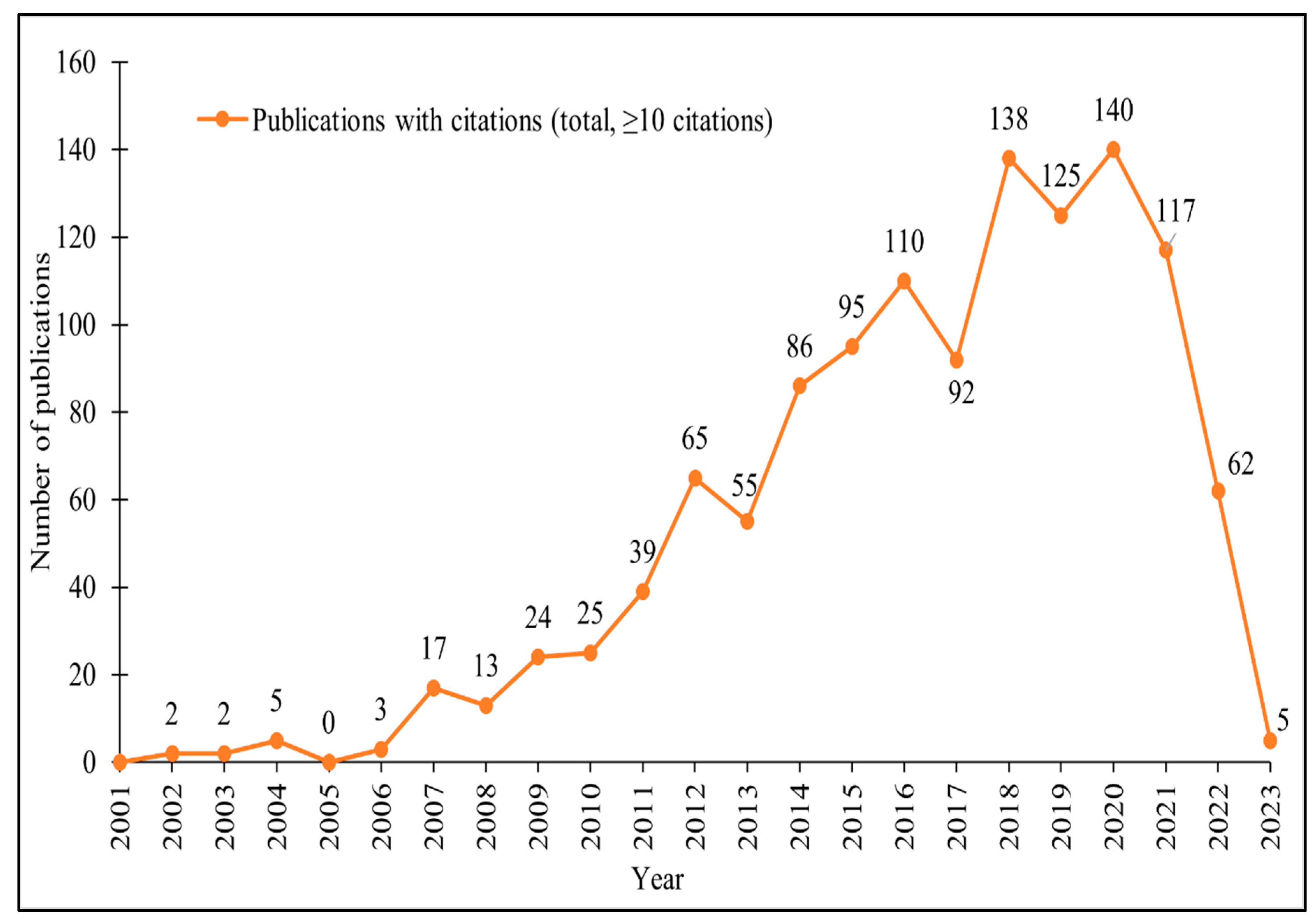



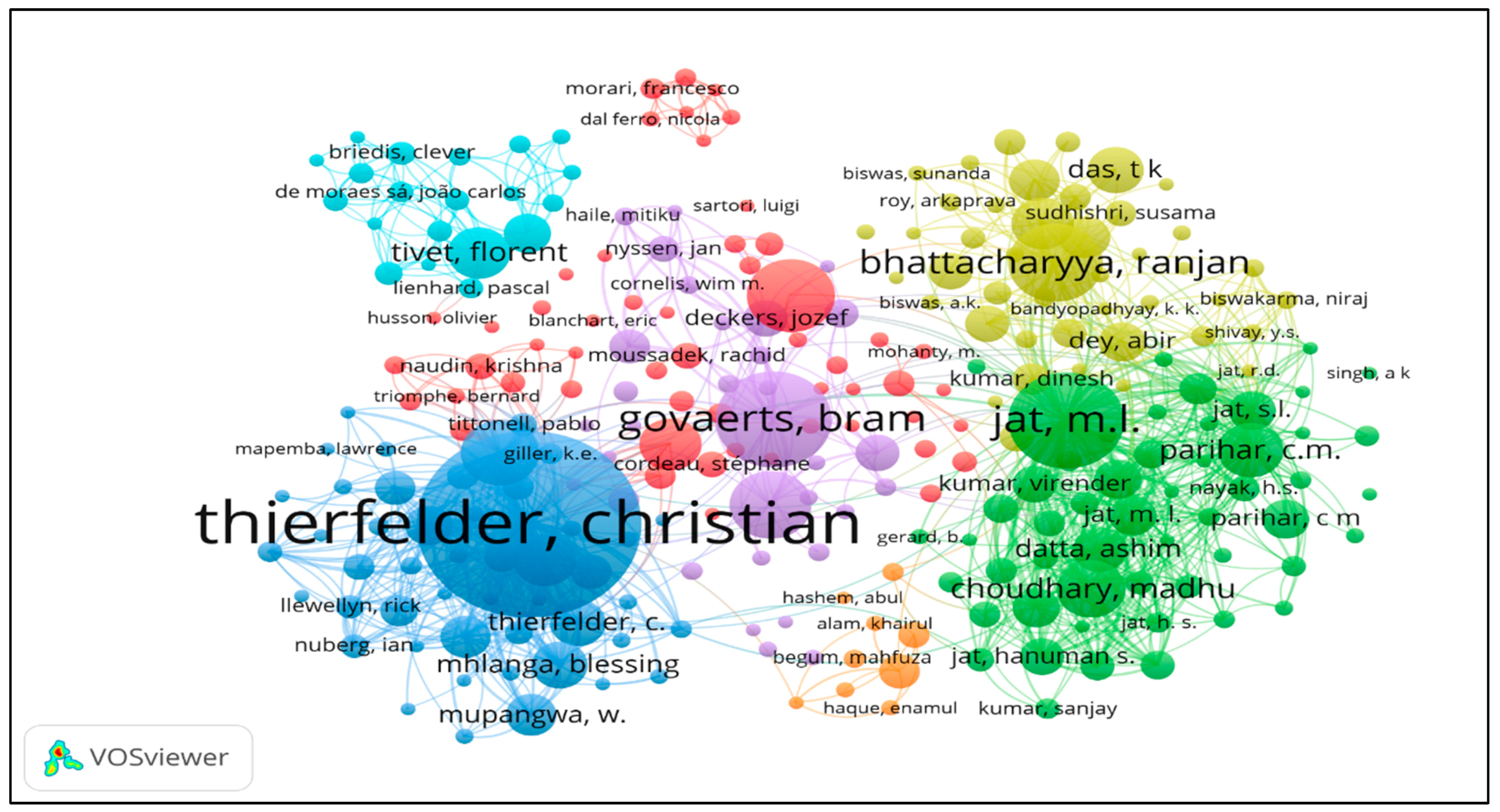

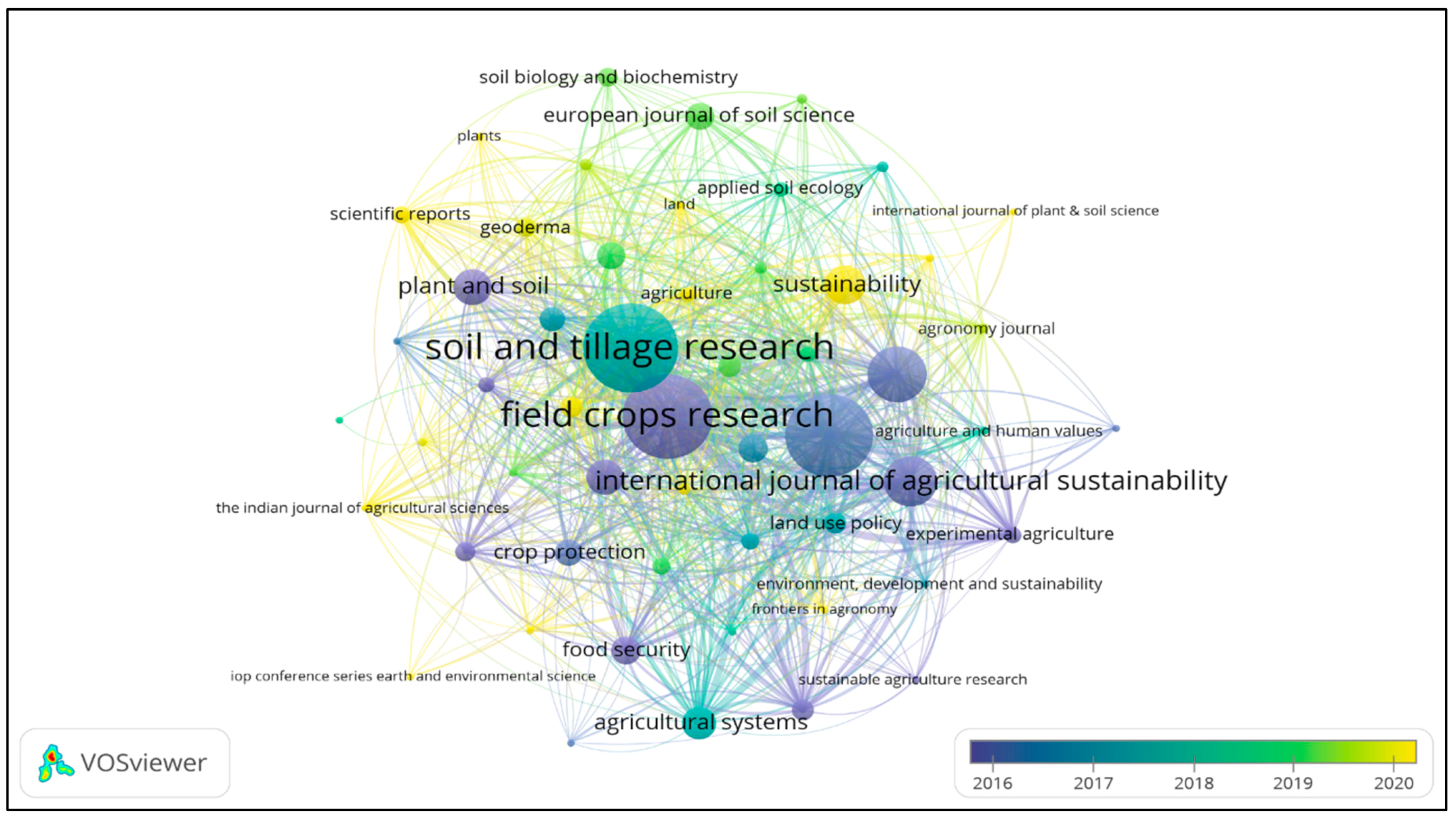


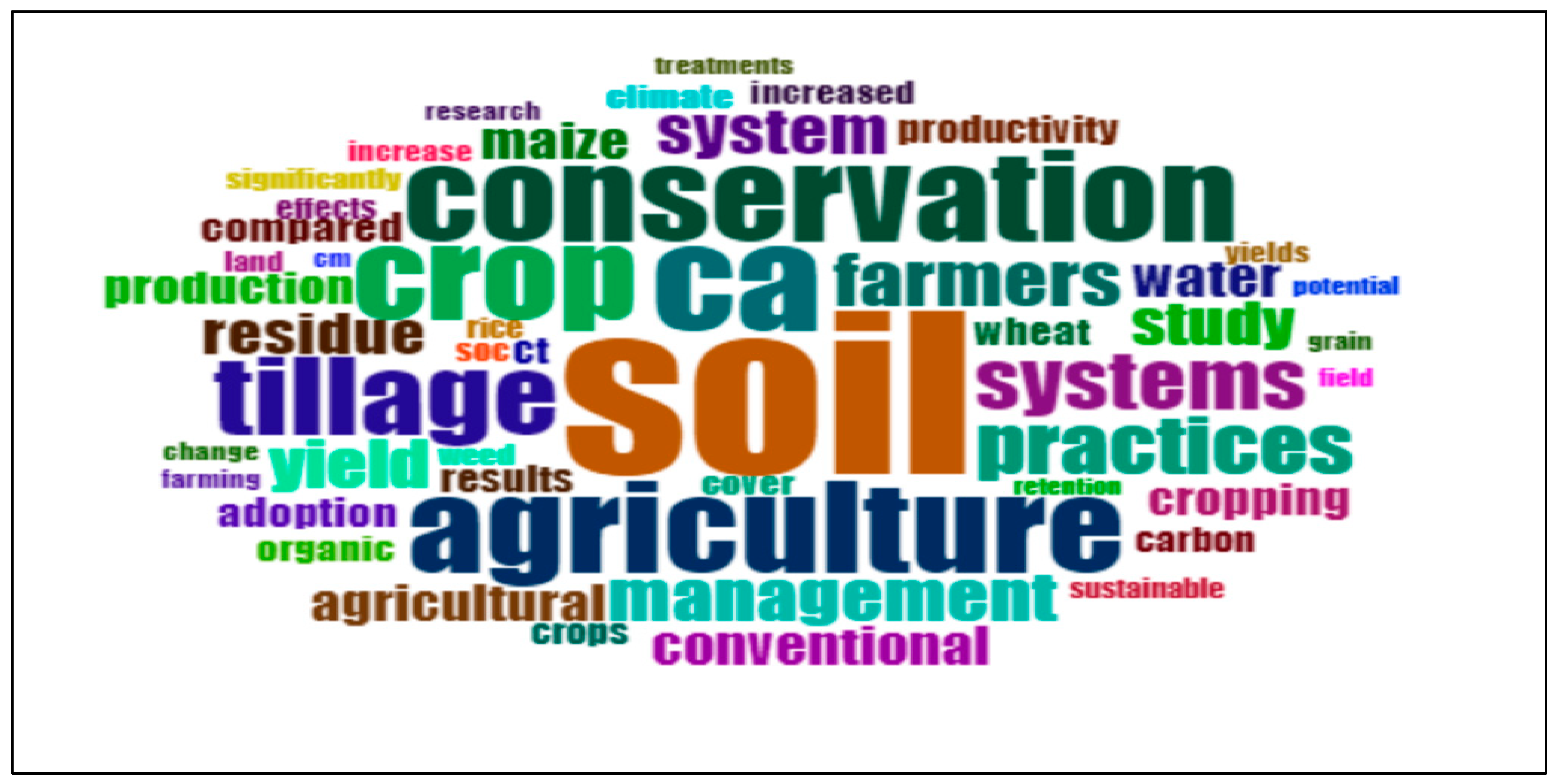


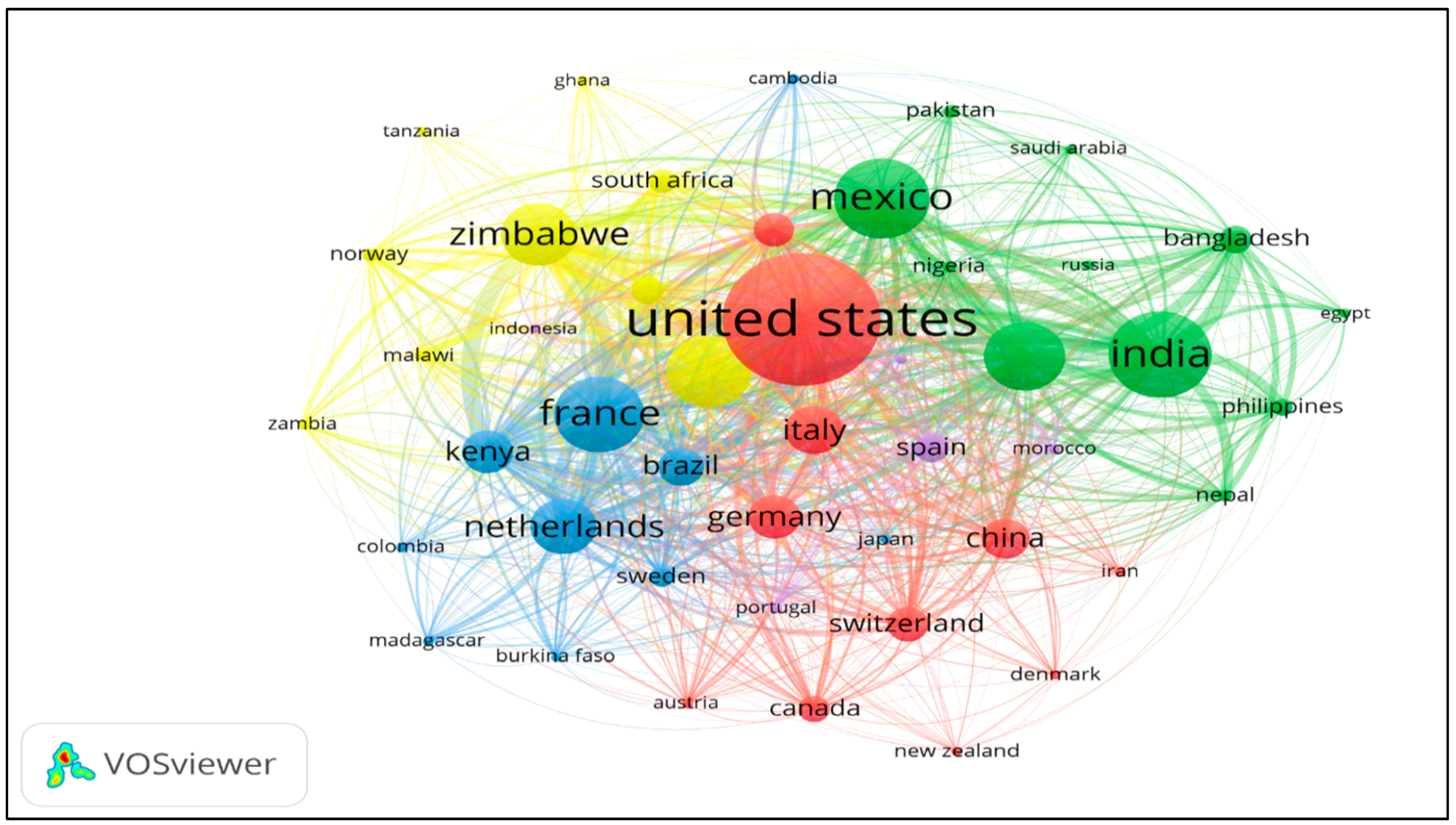

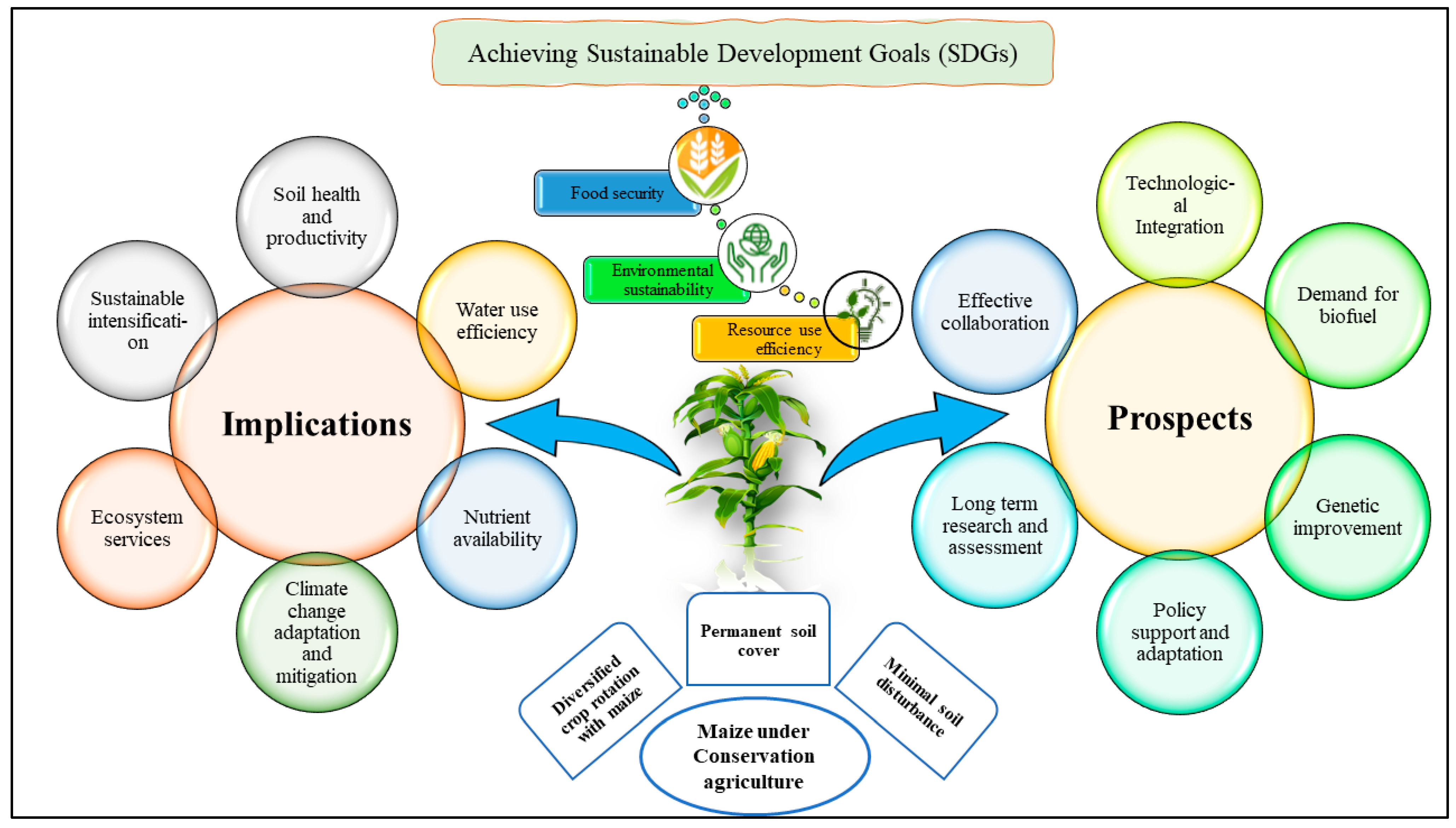
| Sl. No. | Name of Journal | Document Count | Citations | Average Citations per Document |
|---|---|---|---|---|
| 1 | Soil and Tillage Research | 131 | 6861 | 52.4 |
| 2 | Field Crops Research | 85 | 6186 | 72.8 |
| 3 | Agriculture Ecosystems & Environment | 74 | 5648 | 76.3 |
| 4 | Agronomy | 59 | 806 | 13.7 |
| 5 | Sustainability | 55 | 1830 | 33.3 |
| 6 | The Indian Journal of Agricultural Sciences | 50 | 143 | 2.9 |
| 7 | International Journal of Agricultural Sustainability | 41 | 2695 | 65.7 |
| 8 | Agronomy for Sustainable Development | 41 | 3160 | 77.1 |
| 9 | Agricultural Systems | 38 | 1547 | 40.7 |
| 10 | South African Journal of Plant and Soil | 34 | 206 | 6.1 |
| 11 | The Science of The Total Environment | 30 | 1094 | 36.5 |
| 12 | Experimental Agriculture | 28 | 559 | 20.0 |
| 13 | Agriculture | 28 | 471 | 16.8 |
| 14 | International Journal of Current Microbiology and Applied Sciences | 27 | 68 | 2.5 |
| 15 | Geoderma | 26 | 760 | 29.2 |
| 16 | Plant and Soil | 25 | 1650 | 66.0 |
| 17 | Renewable Agriculture and Food Systems | 25 | 780 | 31.2 |
| 18 | Indian Journal of Agronomy | 24 | 10 | 0.4 |
| 19 | Land Degradation and Development | 23 | 507 | 22.0 |
| 20 | Frontiers in Sustainable Food Systems | 23 | 326 | 14.2 |
| Sl. No. | Author’s Name | Organization, Country | Documents | Citations | CP * |
|---|---|---|---|---|---|
| 1 | Christian L. Thierfelder | International Maize and Wheat Improvement Center, Zimbabwe | 88 | 4753 | 54.0 |
| 2 | Mangi Lal Jat | International Maize and Wheat Improvement Center, India | 88 | 4504 | 51.2 |
| 3 | Bram Govaerts | International Maize and Wheat Improvement Center, Mexico | 51 | 3306 | 64.8 |
| 4 | Tapas Kumar Das | Indian Agricultural Research Institute, India | 50 | 1080 | 21.6 |
| 5 | Hanuman Sahay Jat | Central Soil Salinity Research Institute, India | 44 | 2199 | 50.0 |
| 6 | Chiter Mal Parihar | Indian Agricultural Research Institute, India | 44 | 1030 | 23.4 |
| 7 | Nele Verhulst | International Maize and Wheat Improvement Center, Mexico | 36 | 1649 | 45.8 |
| 8 | Parbodh Chander Sharma | Central Soil Salinity Research Institute, India | 36 | 2046 | 56.8 |
| 9 | Rattan A Lal | The Ohio State University, United States | 36 | 3573 | 99.3 |
| 10 | Mahesh Kumar Gathala | International Maize and Wheat Improvement Center, Bangladesh | 35 | 1882 | 53.8 |
| 11 | Ranjan Bhattacharyya | Indian Agricultural Research Institute, India | 34 | 1061 | 31.2 |
| 12 | Walter Tamuka Mupangwa | International Maize and Wheat Improvement Center, Zimbabwe | 33 | 1271 | 38.5 |
| 13 | Marc Corbeels | International Institute of Tropical Agriculture, Kenya | 32 | 3734 | 116.7 |
| 14 | Richard William Bell | Murdoch University, Australia | 26 | 541 | 20.8 |
| 15 | Shankar Lal Jat | ICAR-Indian Institute of Maize Research, India | 25 | 458 | 18.3 |
Disclaimer/Publisher’s Note: The statements, opinions and data contained in all publications are solely those of the individual author(s) and contributor(s) and not of MDPI and/or the editor(s). MDPI and/or the editor(s) disclaim responsibility for any injury to people or property resulting from any ideas, methods, instructions or products referred to in the content. |
© 2024 by the authors. Licensee MDPI, Basel, Switzerland. This article is an open access article distributed under the terms and conditions of the Creative Commons Attribution (CC BY) license (https://creativecommons.org/licenses/by/4.0/).
Share and Cite
Padhan, S.R.; Saini, S.; Jat, S.L.; Rathore, S.S.; Gathala, M.K.; Radheshyam; Padhan, S.R.; El-Hendawy, S.; Mattar, M.A. Bibliometric Trends and Insights into the Potential of Maize (Zea mays) under the Framework of Conservation Agriculture. Sustainability 2024, 16, 8670. https://doi.org/10.3390/su16198670
Padhan SR, Saini S, Jat SL, Rathore SS, Gathala MK, Radheshyam, Padhan SR, El-Hendawy S, Mattar MA. Bibliometric Trends and Insights into the Potential of Maize (Zea mays) under the Framework of Conservation Agriculture. Sustainability. 2024; 16(19):8670. https://doi.org/10.3390/su16198670
Chicago/Turabian StylePadhan, Smruti Ranjan, Sushmita Saini, Shankar Lal Jat, Sanjay Singh Rathore, Mahesh Kumar Gathala, Radheshyam, Soumya Ranjan Padhan, Salah El-Hendawy, and Mohamed A. Mattar. 2024. "Bibliometric Trends and Insights into the Potential of Maize (Zea mays) under the Framework of Conservation Agriculture" Sustainability 16, no. 19: 8670. https://doi.org/10.3390/su16198670










